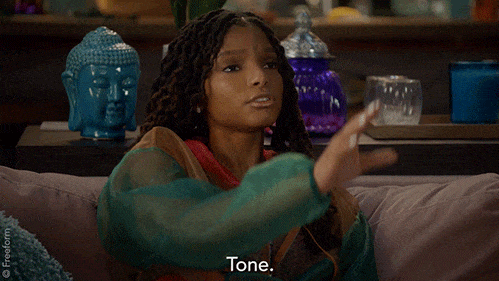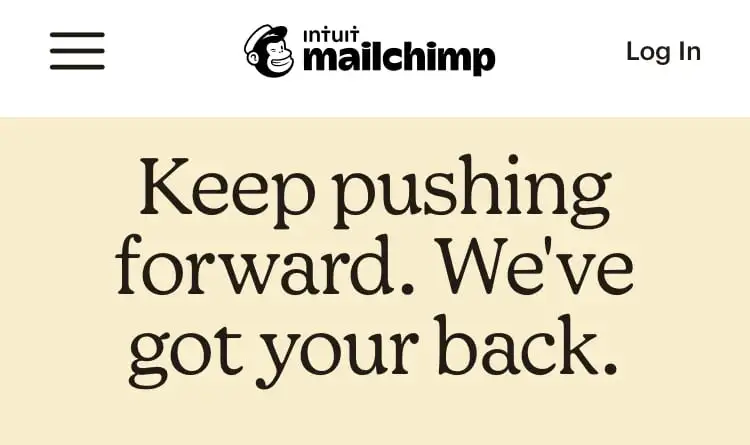Logos, colors palettes, fonts — oh my! When it comes to brand identity, these visual signals get all the glory. While it’s true they provide an instant impression for a brand and help customers recognize a product with a glance, visual identity is only half the story that your brand or business needs to share with the world. The second half? Brand voice.
Brand voice is also known as the verbal identity of a brand. The two go together like peanut butter and jelly, but a strong brand voice remains the elusive part of the duo. This is partly because good writing should, contrary to popular belief, go unnoticed. As Elmore Leonard once famously said, “If it sounds like writing, I rewrite it.”

Couldn’t agree more.
Mostly, though, it comes from a lack of understanding of how to shape this verbal identity and put it into practice. In this article, I’ll shine a light on this part of brand awareness so you can not only give your brand a stunning look but a captivating voice to go along with it. Learn all about what a brand voice is, how to create one, and how to adopt one as a freelance writer.
What is a brand voice?
I like to refer to a brand voice as a brand’s personality. Think about it: when you meet someone at a party, you can quickly get a feel for their personality, even after only a brief conversation. You’ll sense whether they’re serious or funny, outgoing or reserved, respectful or out-there, and so on.
A brand voice works about the same way, except it’s not a party — it’s every form of communication facing the consumer. The brand voice is applied everywhere a brand “speaks” including your website, social media posts, email, ads, and even internal communications.
While the true value of brand voice is difficult to measure, it’s part of the company’s bottom line (according to Forbes!) — that’s to say, it’s hard to launch and even harder to have long-term success without one. That’s because, while you may admire a person because of what they wear, it’s ultimately their personality that makes you fall in love with them.

Or at the very least, helps you recognize if they’re an authentic (hello, consistency!) person you want to invest your time in.
Same with brands. According to a two-year study of 100,000 retail customers, “emotionally connected customers have a 306 percent higher lifetime value (LTV) … and will recommend brands at a much higher rate.”
Brand voice vs brand tone
I’d love to dive deeper into brand voice, but first, it’s important to understand the difference between brand voice and brand tone. Even the best writers can still get the terms confused, because “tone” is actually short for “tone of voice.” Brand voice and tone go hand-in-hand. Here’s a quick breakdown:
- Voice: This describes the company’s consistent personality. It’s always there and spans all communications.
- Tone: Tone changes depending on the situation you are in. It is deliverable-specific.
To go a bit further, think about it like this: your voice could be upbeat, but you would “tone it down” if you were in a serious situation. For example, you might choose to be hopeful or positive toward your friend — which stems from an upbeat voice, yet is the more appropriate choice for the situation at hand.
In the corporate world, tone can change depending on whether you’re handling a customer complaint (more serious) or releasing a new offer on Instagram (more enthusiastic).

Your tone is greatly made up by the cadence (AKA flow of the sentence), too.
Shorter sentences pack more punch. Like this.
Meanwhile, longer, flowy sentences can be used to set the scene, using larger words to take the reader along for the ride so they deeply connect with your storytelling. You see?
This is why, in my professional opinion, every brand voice guide should contain both a “tone” or a “writing for different channels” section as well as a “cadence” section, that gets granular about when it’s important to change your tone in communications.
Brand voice examples
Now back to brand voice. Not sure what you want your brand to sound like? Let’s take a look at some brands that own a unique voice.
Inspiration and motivation with Nike

Constantly looked to as the mecca of motivational copywriting, Nike knows how to transmit emotion in just a few words. So what is Nike’s brand voice? Their tone of voice is described as urgent (just do it—c’mon, that’s a given!), motivational, and encouraging. This goes along with their mission statement which is “To bring inspiration and innovation to every athlete in the world.”
Fun and educational with Mailchimp

Mailchimp has one of the most renowned brand voice guidelines out there. It’s made public, so check it out for yourself! They describe their own brand voice as clear and genuine, with a bit of dry humor — the monkey mascot should have given that one away.
A mixed bag with Netflix
So, what is Netflix’s brand voice, you ask? To match the mood of those watching their streaming service it’s relaxed, interesting, and conversational. For example, they don’t call their platform a streaming service, they simply say “See What’s Next.”
However, over on social media, they’ve been known to be more humorous and irreverent.

While this is an example of writing for a specific channel, you don’t always need to have such a dramatic change (like handing over the account to a Gen Z intern) just to adjust the tone. In my opinion, this is an inconsistent voice.
Tongue-in-cheek with Reformation

One of my favorite eCommerce brands that nail a recognizable and colloquial brand voice is Reformation. Casual and playful with a touch of daring — they are consistent from their tagline (“Being naked is the #1 most sustainable option. We’re #2”) to their email and social media campaigns. Want a fun swipe file? Sign up for their newsletter!
How to perform brand voice research
Whether you’re just starting to build a company brand from scratch or you’re a personal brand that runs on being you, a consistent voice is a must.
To get started, consider one of these research avenues (or a mixture of all three!).
1. Look at competitors for brand positioning
Oftentimes, you can shape the brand voice by asking: “What don’t we want our brand voice to be?” Looking at the competition, it’s usually easy to find a sea of sameness. If everyone’s in the beauty field trying to be cutesy, what if you were the one with the bold, rebellious voice? Think Liquid Death and Cards Against Humanity as brands using voice to stand out from the crowd.
2. Research your audience
It’s best practice to create something that your audience wants, and not just create a brand voice in a silo. If you have an audience, create a simple poll asking how they see your brand. Include one or both of the following questions:
- In one word, how would you describe our brand?
- If our company were a person, who would it be?
Don’t want to bother them? No worries! Check out my favorite tool in my copywriter arsenal: Voice of customer data. Experts have shown that mirroring your audience’s communication patterns allows them to feel a sense of belonging.
Where can you find it? Dig into your reviews, testimonials, Reddit threads, Facebook groups, and what have you to see how your customers describe your brand there.
3. Audit your high-performing content
To see what resonates with your audience, take stock of your popular pieces. Whether it’s blog posts, a Linkedin post, a video, or even your about page, these may provide insights as to what your audience likes to see/read from you.
8 steps to develop a brand voice
Once you have the brand voice research part done, it’s time to start documenting. A study from Lucidpress on brand consistency shows that over 60 percent of organizations have said materials “always, often or sometimes” don’t conform to brand guidelines.
My mission in life is to change that!
Clear guidelines not only help shape and solidify the brand voice, but they also enforce consistency across channels and help writers (or anyone on the team for that matter!) write with clarity and confidence — which is vital for customer loyalty.
A brand voice chart or guide is completely adjustable — meaning you can add or subtract sections as you see fit — but the following steps are almost always part of the package.
1. Start with your company’s core values and mission statement
A brand identity is made up of what your brand’s core values are and how you communicate your product, so starting here is best practice. If you’re stuck, start with some “I believe” sentences to get ideas flowing in the right order. For example, an HR team might shape their mission by saying, “I believe every candidate deserves a personalized phone call if they are not selected for the role.”
2. Define your target audience
Who are you talking to and who are you writing for? Building out an effective persona can help you figure out how best to communicate with them.
3. List your product or service suite
List out your products or offerings and note if there is any certain way you describe them. This helps keep the product/brand positioning consistent. For example, if you’re a service provider, think about the naming of your signature offer and your own title. Are you a Confidence Coach with a “Get Going! Framework”? Is that capitalized or not? Does it have a registered trademark or not? Solidify it here and now.
4. Create your brand personality

Remember when I said brand voice is like a person you met at a party? Now’s the time to define who your brand is at the said fiesta. Whether it’s akin to Julia Roberts or you want to make up a character like “doctor who happens to be a friend” to evoke a knowledgeable yet down-to-earth personality, it’s up to you.
Using voice analytic tools and a proprietary process, I believe everyone falls into one of nine different personality types. Get in touch with me to find out yours and bypass the research!
5. Define your tone of voice
Now that you have the vision, offering, and personality shaped, think about how the brand talks. Try to define it in three words, or try the “this but not that” technique, e.g.:
- Hopeful but realistic
- Educated but real-world savvy
- Supportive but not coddling
This helps writers understand that “happy medium” tone.
6. Tailor the voice for different channels
Think about where you will need customer-facing texts in your content marketing. Does the tone need to change for any of these channels? For example, are emojis a no-no except for on Instagram? Is some jargon language okay for your emails (where your customers are more tech-savvy) but not for your website (that targets more stages of awareness than one)? Get specific here.
7. Assign accountability
Next, assign accountability for enforcing the guidelines to one team member, such as the lead copywriter, content manager, or yourself!
8. Flesh out the brand voice in the style guide
Lastly, here’s a laundry list of additional guidelines you can add to expand your style guide’s brand messaging section and get more granular.
- Dos and don’ts: Use specific examples of how to write and how not to write.
- Grammar: E.g., AP Style, Chicago Style, etc.
- Pronouns: Do you refer to the business in the first person (“I”) or third person (“we”)?
- Lexicon: Terms your audience will or will not understand.
- Cadence: How many words per sentence you use, on average.
- Word bank: A grab-bag list of adjectives and nouns that are “on brand.”
- Additional mechanics: Capitalization, contractions, bulleted and numbered lists, dates, currency, and more.
Remember: this is a living, breathing document! While I love creating a designed PDF (because, again, copy and design go together like peanut butter and jelly!), a style guide only needs to be in a Google document. This means you can shape it with time and according to how your audience responds to it.
Tips on writing in a brand’s voice
If you are working as a freelance writer, you’ve likely encountered many different brands and businesses with differing voices. The most accomplished freelancers are able to adjust their writing style to match the voice of each brand.

In fact, behind price, voice is the number one concern when hiring a copywriter, according to the team behind the Codex Persona.
In my experience working as an in-house copywriter, most larger businesses will have a style guide already set in place that details their voice and tone. Your first step to nailing voice during your freelance writing assignment is to ask the person who contracted you if they have a style guide or voice guidelines.
Beyond that, these tips are similar to the research phase of building a brand voice, but less intensive. Here’s what you can do to nail your client’s voice:
- Ask for examples: Ask your client for a list of websites/brands they’d like to emulate and find the commonalities between them… then follow that pattern.
- Mimic existing content: Gather a representative sample of their content and match the tone, word choice, and cadence.
- Observe: Ask to schedule a phone call or review video content of your client to see how they speak, taking note of phrases and words the person repeats a lot.
- Survey: Create a brand voice survey that includes the above tips and ask your client to choose a personality that resonates with them.
Nail brand voice and become the life of the party!
Thinking of it in this way, you can see how the power of brand voice brings your brand to life, attracts your ideal audience, and can even shape your brand positioning. Whether you’re starting from scratch or looking to write with more purpose, brand voice is the key element. Let it work together with the visual identity, and you’ll have an unstoppable brand strategy in no time.


